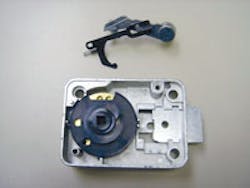Mechanical combination locks have been around since the mid-1800s and have not changed much in their design. Current locks consist of three or four, wheels, a lever, bolt, and a cam that accepts a threaded dial spindle which must be “splined” together with a spline key. Splining, or mis-splining, of a mechanical combination lock has been the subject of numerous articles over the last 30 years, as correct splining is critical in order to avoid accidentally setting the combination in the “forbidden zone.” Changing the lock design to eliminate splining entirely is the most significant change to the new mechanical combination lock being introduced by Nick Gartner, founder of La Gard, and most recently Lock Technology BV. While still consisting of three wheels, a lever and bolt, Gartner’s lock cam is not threaded and is not splined with a key together with the dial spindle. (Figure 1)
As a brief recap, splining of a mechanical combination lock is determined by the position of the lock bolt when it is mounted on a safe door. The positions are right-hand (RH), left-hand (LH), VU (vertical up) and VD (vertical down). Incorrect splining causes the “forbidden zone,” considered to be from 0 to 20 (third number of the combination) to change accordingly around the dial and becomes lost. When this forbidden zone occurs in an area other than “0 to 20” on the dial, it is just a matter of time before someone unknowingly sets (what should normally be a “safe” number for the last number of the combination) a number in the forbidden zone, causing a lockout or lock-in. This forbidden zone has also been the subject of many articles over the years and is the number two cause (forgetting the combination is number one) of mechanical combination lock failure. In fact, in the Locksmith Ledger in March 1988, Harry Miller wrote that “[the forbidden zone] is like a time bomb waiting to explode”.
The new Mechanical Combination lock’s cam accepts a 6mm square shaft with cut-off points and has a star washer in the lock shaft hole. (See Figure 2) With the introduction of a square shaft, the lock can be mounted in any of the four positions (RH, LH, VU, VD), without removing the lock cover, making it the first truly sealed lock. To mount the lock and mate the dial, with the lock in the OPEN position (bolt retracted), the dial is held so that the number 93 (approximately) is lined up on the dial’s Opening Index (Figure 3), then the shaft pushed into the lock with a slight bit of pressure. The shaft cannot be pulled out as it is held with the star washer.
There are several significant advantages to this new cam/shaft design:
1. Forbidden Zone: In addition to avoiding forbidden zone problems because of not splining, the forbidden zone is smaller on the new mechanical combination lock. While current locks use 0 to 20 as the forbidden zone for the third number of the combination, 0 to 10 is the recommended range on the new lock.
2. Square Dial Shaft: The cut-off length of the shaft is not as critical as on a threaded spindle. “No Spy” dials from Lock Technology BV come standard with a detachable square shaft with cut-off points (little steps). When the shaft is cut to length, the cut-off points create a chamfered area (unlike the threaded spindles that must be deburred after cutting). The square chamfered area creates a positive location into the star washer then through the cam. Additionally, as the shaft is shipped detached from the dial, it does not take up extra space as occurs with dials shipped with the spindles pressed in.
3. Cost-effective to Install: The lock can be installed quickly and easily. Not having to remove the back cover saves time. No errors are caused by mis-splining, or by having a loose or incorrect spline key. With the chamfered cut-off point on the shaft, time is not spent on deburring the end of the spindle and the length is not that critical.
Also new in the design is an integrated bolt detent and relocker (Figure 4). Additionally, there are optional auxiliary bolts for three-way locking, which are not found on currently manufactured locks (Figure 5). In March 2006, the new mechanical combination lock successfully passed VdS testing, including manipulation, and will be submitted very shortly for UL Group 2M testing. The No-Spy dials come in black plastic as well as zamak with mat chrome and gold plating.
For 150 years, mechanical combination locks were essentially the same design and the same inherent problems. Now, a new design solves some old problems as well as creating some cost-effective features.
Nick Gartner is the inventor of Lock Technology’s new mechanical combination lock, and the CEO of the company. He also invented La Gard’s series 1800, 3330, and 3370 locks as well as S&G’s series 8500 MP combination lock. Look for future articles on Gartner’s new security products.
